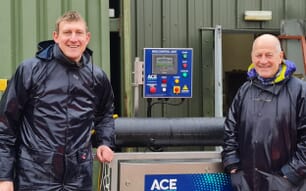In this case, the fish is targeted to the US troops. Sodexo, a Fortune 500 company home based in France, has an eight year contract to provide food services to US military mess halls, including $22 million of seafood each year.
It’s very likely that many other Americans also are not benefitting from Alaska seafood, as Sodexo provides foods to hundreds of federal, state and private hospitals, schools, prisons, assisted living centers and other facilities across the country.
In a letter to Sodexo USA CEO George Chavel, Senator Mark Begich called the salmon snub “outrageous and an “appalling insult.”
“This company has decided that because of some labeling issue, they don’t think Alaska fish products meet their standards,” Begich fumed during a phone call as he was leaving a fisheries hearing in Kenai. “We believe the certification we have through Global Trust, the same that Canada and Iceland receive on their fish products, is as high a standard, if not higher, than what Sodexo wants.”
The MSC spearheaded the sustainable seafood movement in 1997 – showcasing Alaska’s salmon fishery as its first big certification success. The Alaska salmon industry opted out of the MSC program last year, due to growing logo and licensing costs and concerns over inconsistent standards.
Sodexo follows Wal-Mart and the US Park Service in the fish fight of opting to exclude Alaska salmon based on an eco-label. Both were quick to claim “salmon love” but admitted they do not have a clear understanding of Alaska’s new third party certification standards.
“What we are really asking is for ASMI, and others who are closely involved in the industry to educate us and give us more information,” said Chris Schraeder, Wal-Mart’s Senior Manager of Sustainability Communications. Members of the Alaska Seafood Marketing Institute and other industry stakeholders are scheduled to meet with Wal-Mart at its Arkansas headquarters next month.
Similarly, Senator Begich said on Friday that Sodexo USA called him to say they want to work with Alaska and resolve the seafood spat.
“They understand now that there are issues they were unaware of about Alaska’s sustainability programs, and how we track our products. We are happy to educate them,” Begich said.
He added: “In a backhanded way, all of this lets us tout the benefits of Alaska fish, and make something positive out of an adverse situation. I feel it is my responsibility to promote seafood for Alaska and all US fisheries and this gives me a chance to contact these companies directly.”
As chairman of the committee on Oceans, Atmosphere, Fisheries, and Coast Guard, Senator Begich said he is ready to add eco-labeling clarifications to the Magnuson-Stevens Act as it undergoes reauthorization.
People put down – People magazine is next up to receive an irate letter from Senator Begich and other Alaskans for its recommendation that farmed fish is “a better choice” than wild caught fish.
In his blog this week titled "The best fish to buy," fitness and health food guru Harley Pasternak wrote that the many benefits of farmed seafood include “a reduced likelihood of contamination from mercury and PCBs,” which “are not as much of a risk in a controlled, farmed environment."
It is gratifying to see that readers gave the guru’s fish recommendations big thumbs down. Nearly all of the 60 comments bashed Pasternak – “a hit job on our fisheries”… “a shill for the farm fish industry”…”think he’d eat it with a 10 foot pole?”… “Real fish don’t eat pellets” … “farm raised is genetically modified food”… and chastised him for a poorly researched article that will likely scare people away from eating more seafood. People ranks in the top 10 of America’s most popular magazines with a circulation of 3.5 million.
Who fishes where - Many people are surprised to learn that 80 percent of Alaska’s seafood landings come from federal waters, meaning from three to 200 miles offshore. Oversight falls to the North Pacific Fishery Management Council and their staff has compiled a booklet profiling the fishing fleets through 2010, with an addendum for 2011 that includes names of every boat.
Some highlights for 2011: 81 trawl boats and 16 catcher-processors fish in the Bering Sea; 98 trawlers fish in the Central and Western Gulf. There are 67 groundfish longline vessels, 137 pot boats, and 118 vessels in the jig fleet.
Seventy seven boats make up the Bering Sea/Aleutian Islands crab fleet, four scallopers and 1,457 boats fish for halibut and sablefish.
While most people imagine huge vessels in the federal water fisheries, 80 percent are less than 60 feet. By far, most of the boats were built in the 1970s and 1980s.
Most of the catch in 2010 – 54% - was Alaska pollock, followed by flatfishes at 18% and cod at 15%. Halibut and sablefish were just one percent of the total catch; shellfish at 2 percent.
As to where the fleets call home – most of the large at-sea catcher processors report Seattle as their homeport; most of the catcher boats that deliver to shore plants hail from Alaska.
Major ports for groundfish are Kodiak, Homer and Sand Point. For halibut and sablefish, top homeports are Homer, Kodiak, Juneau, Petersburg and Sitka. Find a link at www.alaskafishradio.com
Salmon watch – Alaska’s total salmon catch has already set a record and the fish are still coming on strong. By August 23 the total harvest topped 241 million (the old record was 222 million in 2005), pushed by huge surges of humpies.
The total pink salmon catch was 192 million – the old record was 161 million in 2005. At Prince William Sound, the pink harvest was over 87 million fish; at Southeast, the pink catch was approaching 73 million; and at Kodiak the pink catch topped 23 million.
Other statewide salmon totals were: Chinook – 303,000; Chum – 17 million; Coho – 3 million; Sockeye – 29 million.



